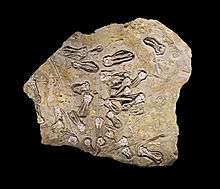Artinskian
| System/ Period |
Series/ Epoch |
Stage/ Age |
Age (Ma) | |
|---|---|---|---|---|
| Triassic | Lower/ Early |
Induan | younger | |
| Permian | Lopingian | Changhsingian | 251.902 | 254.14 |
| Wuchiapingian | 254.14 | 259.1 | ||
| Guadalupian | Capitanian | 259.1 | 265.1 | |
| Wordian | 265.1 | 268.8 | ||
| Roadian | 268.8 | 272.95 | ||
| Cisuralian | Kungurian | 272.95 | 283.5 | |
| Artinskian | 283.5 | 290.1 | ||
| Sakmarian | 290.1 | 295.0 | ||
| Asselian | 295.0 | 298.9 | ||
| Carboniferous | Pennsylvanian | Gzhelian | older | |
| Subdivision of the Permian system according to the ICS, as of 2017.[1] | ||||
In the geologic timescale, the Artinskian is an age or stage of the Permian. It is a subdivision of the Cisuralian epoch or series. The Artinskian lasted between 290.1 and 283.5 million years ago (Ma). It was preceded by the Sakmarian and followed by the Kungurian.[2]
Stratigraphy

The Artinskian is named after the small Russian city of Arti (formerly Artinsk), situated in the southern Ural mountains, about 200 km southwest of Yekaterinburg. The stage was introduced into scientific literature by Alexander Karpinsky in 1874.
The base of the Artinskian stage is defined as the place in the stratigraphic record where fossils of conodont species Sweetognathus whitei and Mesogondolella bisselli first appear. As of 2009, there was no agreement yet on a global reference profile (a GSSP) for the base of the Artinskian. The top of the Artinskian (the base of the Kungurian) is defined as the place in the stratigraphic record where fossils of conodonts Neostreptognathodus pnevi and Neostreptognathodus exculptus first appear.
Palaeontology
Amphibians
| Amphibians of the Artinskian | ||||
|---|---|---|---|---|
| Taxa | Presence | Location | Description | Images |
| North America | ||||
| Boskovice Furrow, Czech Republic | ||||
| Abo Formation, New Mexico and Seymour, Baylor County, Texas | ||||
Arthropods
| Arthropods of the Artinskian | ||||
|---|---|---|---|---|
| Taxa | Presence | Location | Description | Images |
| Kansas and Oklahoma | ||||
Synapsids
| Synapsids of the Artinskian | ||||
|---|---|---|---|---|
| Taxa | Presence | Location | Description | Images |
|
Greene Formation, Ohio; Belle Plains Formation, Texas; Cutler Formation, Utah, all in the USA |
||||
| Kasimovian-Kungurian |
Kenilworth, Kenilworth Sandstone Formation, Warwickshire Group, Warwickshire, England; Autun, France, Cutler Formation, Arizona, Colorado, New Mexico and Utah; Fort riley, Chase Group, Kansas, Greene Formation, Dunkard Group, Ohio; Wellington Formation, Oklahoma; Clyde Formation, Texas and Oklahoma; Admiral Formation; Belle-Plains Formation; Wichita Group, all three in Texas, |
|||
| Wichita Group and Clear Fork Group, both in Texas, USA | ||||
| Gzhelian-Artinskian | New Mexico; Utah-Arizona border region, both in USA; possibly England | The English specimen known as S?. brittanicus ) is now generally classified as Sphenacodontidae incertae sedis separate from the other Sphenacodon species so may need reassigning. | ||
References
- ↑ http://www.stratigraphy.org/index.php/ics-chart-timescale
- ↑ Gradstein, F.M.; Ogg, J.G. & Smith, A.G.; 2004: A Geologic Time Scale 2004, Cambridge University Press
External links
- GeoWhen Database - Artinskian
- Upper Paleozoic stratigraphic chart at the website of the subcommission for stratigraphic information of the ICS